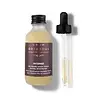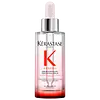What's inside
What's inside
 Key Ingredients
Key Ingredients

 Benefits
Benefits

 Concerns
Concerns

 Ingredients Side-by-side
Ingredients Side-by-side

Water
Skin ConditioningButylene Glycol
HumectantCaffeine
Skin ConditioningMaltodextrin
AbsorbentDimethyl Isosorbide
SolventPropanediol
SolventGlycerin
HumectantPPG-26-Buteth-26
Skin ConditioningParfum
MaskingPhenoxyethanol
PreservativePEG-40 Hydrogenated Castor Oil
EmulsifyingPolyacrylate Crosspolymer-6
Emulsion StabilisingArginine
MaskingXanthan Gum
EmulsifyingHydroxyethylcellulose
Emulsion StabilisingLactic Acid
BufferingGlycine Soja Germ Extract
EmollientTriticum Vulgare Germ Extract
Skin ConditioningChlorphenesin
AntimicrobialAllantoin
Skin ConditioningSodium Benzoate
MaskingHydrolyzed Hyaluronic Acid
HumectantPisum Sativum Sprout Extract
Skin ConditioningGluconolactone
Skin ConditioningTrisodium Ethylenediamine Disuccinate
Scutellaria Baicalensis Root Extract
AstringentGlycine
BufferingLarix Europaea Wood Extract
HumectantSodium Metabisulfite
AntioxidantT-Butyl Alcohol
PerfumingDextran
Limonene
PerfumingLinalool
PerfumingRhizobian Gum
Sodium Hyaluronate
HumectantAlpha-Isomethyl Ionone
PerfumingCinnamyl Alcohol
PerfumingZinc Chloride
AntimicrobialCamellia Sinensis Leaf Extract
AntimicrobialAcetyl Tetrapeptide-3
Skin ProtectingTrifolium Pratense Flower Extract
AstringentCalcium Gluconate
HumectantCitric Acid
BufferingSodium Hydroxide
BufferingWater, Butylene Glycol, Caffeine, Maltodextrin, Dimethyl Isosorbide, Propanediol, Glycerin, PPG-26-Buteth-26, Parfum, Phenoxyethanol, PEG-40 Hydrogenated Castor Oil, Polyacrylate Crosspolymer-6, Arginine, Xanthan Gum, Hydroxyethylcellulose, Lactic Acid, Glycine Soja Germ Extract, Triticum Vulgare Germ Extract, Chlorphenesin, Allantoin, Sodium Benzoate, Hydrolyzed Hyaluronic Acid, Pisum Sativum Sprout Extract, Gluconolactone, Trisodium Ethylenediamine Disuccinate, Scutellaria Baicalensis Root Extract, Glycine, Larix Europaea Wood Extract, Sodium Metabisulfite, T-Butyl Alcohol, Dextran, Limonene, Linalool, Rhizobian Gum, Sodium Hyaluronate, Alpha-Isomethyl Ionone, Cinnamyl Alcohol, Zinc Chloride, Camellia Sinensis Leaf Extract, Acetyl Tetrapeptide-3, Trifolium Pratense Flower Extract, Calcium Gluconate, Citric Acid, Sodium Hydroxide
Water
Skin ConditioningAlcohol Denat.
AntimicrobialArginine
MaskingPEG-40 Hydrogenated Castor Oil
EmulsifyingCitric Acid
BufferingNiacinamide
SmoothingCalcium Pantothenate
Caffeine
Skin ConditioningLimonene
PerfumingPyridoxine Hcl
Skin ConditioningLinalool
PerfumingPolyquaternium-11
Safflower Glucoside
Benzyl Salicylate
PerfumingCoumarin
PerfumingCitral
PerfumingBenzyl Alcohol
PerfumingXylitylglucoside
HumectantCitronellol
PerfumingBenzyl Benzoate
AntimicrobialAnhydroxylitol
HumectantXylitol
HumectantZingiber Officinale Water
MaskingZingiber Officinale Root Extract
MaskingResveratrol
AntioxidantTocopherol
AntioxidantBHT
AntioxidantSodium Citrate
BufferingParfum
MaskingWater, Alcohol Denat., Arginine, PEG-40 Hydrogenated Castor Oil, Citric Acid, Niacinamide, Calcium Pantothenate, Caffeine, Limonene, Pyridoxine Hcl, Linalool, Polyquaternium-11, Safflower Glucoside, Benzyl Salicylate, Coumarin, Citral, Benzyl Alcohol, Xylitylglucoside, Citronellol, Benzyl Benzoate, Anhydroxylitol, Xylitol, Zingiber Officinale Water, Zingiber Officinale Root Extract, Resveratrol, Tocopherol, BHT, Sodium Citrate, Parfum
 Reviews
Reviews

Ingredients Explained
These ingredients are found in both products.
Ingredients higher up in an ingredient list are typically present in a larger amount.
Arginine is an amino acid that is important for human development. Your body uses is it to produce hair keratin and skin collagen.
As a cosmetic ingredient, Arginine has antioxidant properties and can also help repair damaged skin. This ingredient is derived either synthetically or from animals.
Arginine isn't fungal acne safe when used in the presence of other lipids (fats, fatty acids, oils, esters, etc). Oils and fats occur naturally within the skin, so take caution when using Arginine if you're prone to fungal acne.
Learn more about ArginineCaffeine is most associated with coffee, tea, and cacao. In skincare, it helps with calming inflammation and is rich in antioxidants.
While caffeine is used to treat cellulite and and dark circles, further studies are needed to prove this. It has been believed to help with these skin conditions due to its ability to dilate blood vessels and increase blood flow.
Some studies are looking into caffeine's ability to protect against UV rays.
Learn more about CaffeineCitric Acid is an alpha hydroxy acid (AHA) naturally found in citrus fruits like oranges, lemons, and limes.
Like other AHAs, citric acid can exfoliate skin by breaking down the bonds that hold dead skin cells together. This helps reveal smoother and brighter skin underneath.
However, this exfoliating effect only happens at high concentrations (20%) which can be hard to find in cosmetic products.
Due to this, citric acid is usually included in small amounts as a pH adjuster. This helps keep products slightly more acidic and compatible with skin's natural pH.
In skincare formulas, citric acid can:
While it can provide some skin benefits, research shows lactic acid and glycolic acid are generally more effective and less irritating exfoliants.
Most citric acid used in skincare today is made by fermenting sugars (usually from molasses). This synthetic version is identical to the natural citrus form but easier to stabilize and use in formulations.
Read more about some other popular AHA's here:
Learn more about Citric AcidLimonene is a fragrance that adds scent and taste to a formulation.
It's found in the peel oil of citrus fruits and other plants such as lavender and eucalyptus. The scent of limonene is generally described as "sweet citrus".
Limonene acts as an antioxidant, meaning it helps neutralize free radicals.
When exposed to air, oxidized limonene may sensitize the skin. Because of this, limonene is often avoided by people with sensitive skin.
The term 'fragrance' is not regulated in many countries. In many cases, it is up to the brand to define this term. For instance, many brands choose to label themselves as "fragrance-free" because they are not using synthetic fragrances. However, their products may still contain ingredients such as essential oils that are considered a fragrance.
Learn more about LimoneneLinalool is a fragrance and helps add scent to products. It's derived from common plants such as cinnamon, mint, citrus, and lavender.
Like Limonene, this ingredient oxidizes when exposed to air. Oxidized linalool can cause allergies and skin sensitivity.
This ingredient has a scent that is floral, spicy tropical, and citrus-like.
Learn more about LinaloolParfum is a catch-all term for an ingredient or more that is used to give a scent to products.
Also called "fragrance", this ingredient can be a blend of hundreds of chemicals or plant oils. This means every product with "fragrance" or "parfum" in the ingredients list is a different mixture.
For instance, Habanolide is a proprietary trade name for a specific aroma chemical. When used as a fragrance ingredient in cosmetics, most aroma chemicals fall under the broad labeling category of “FRAGRANCE” or “PARFUM” according to EU and US regulations.
The term 'parfum' or 'fragrance' is not regulated in many countries. In many cases, it is up to the brand to define this term.
For instance, many brands choose to label themselves as "fragrance-free" because they are not using synthetic fragrances. However, their products may still contain ingredients such as essential oils that are considered a fragrance by INCI standards.
One example is Calendula flower extract. Calendula is an essential oil that still imparts a scent or 'fragrance'.
Depending on the blend, the ingredients in the mixture can cause allergies and sensitivities on the skin. Some ingredients that are known EU allergens include linalool and citronellol.
Parfum can also be used to mask or cover an unpleasant scent.
The bottom line is: not all fragrances/parfum/ingredients are created equally. If you are worried about fragrances, we recommend taking a closer look at an ingredient. And of course, we always recommend speaking with a professional.
Learn more about ParfumPeg-40 Hydrogenated Castor Oil is derived from castor oil and polyethylene glycol (PEG). It is used as a emollient and emulsifier.
As an emulsifier, it helps prevent ingredients from separating. It also helps make the other ingredients more soluble; it is often used to solubilize fragrances. This increases spreadability and elongates shelf life in a product.
Emollients help soothe and soften the skin. They do this by creating a protective film on your skin. This barrier helps trap moisture and keeps your skin hydrated. Emollients may be effective at treating dry or itchy skin.
This ingredient may or may not be vegan, depending on the source.
Peg-40 Hydrogenated Castor Oil may not be fungal-acne safe. We recommend speaking with a professional if you have any questions or concerns.
Learn more about PEG-40 Hydrogenated Castor OilWater. It's the most common cosmetic ingredient of all. You'll usually see it at the top of ingredient lists, meaning that it makes up the largest part of the product.
So why is it so popular? Water most often acts as a solvent - this means that it helps dissolve other ingredients into the formulation.
You'll also recognize water as that liquid we all need to stay alive. If you see this, drink a glass of water. Stay hydrated!
Learn more about Water